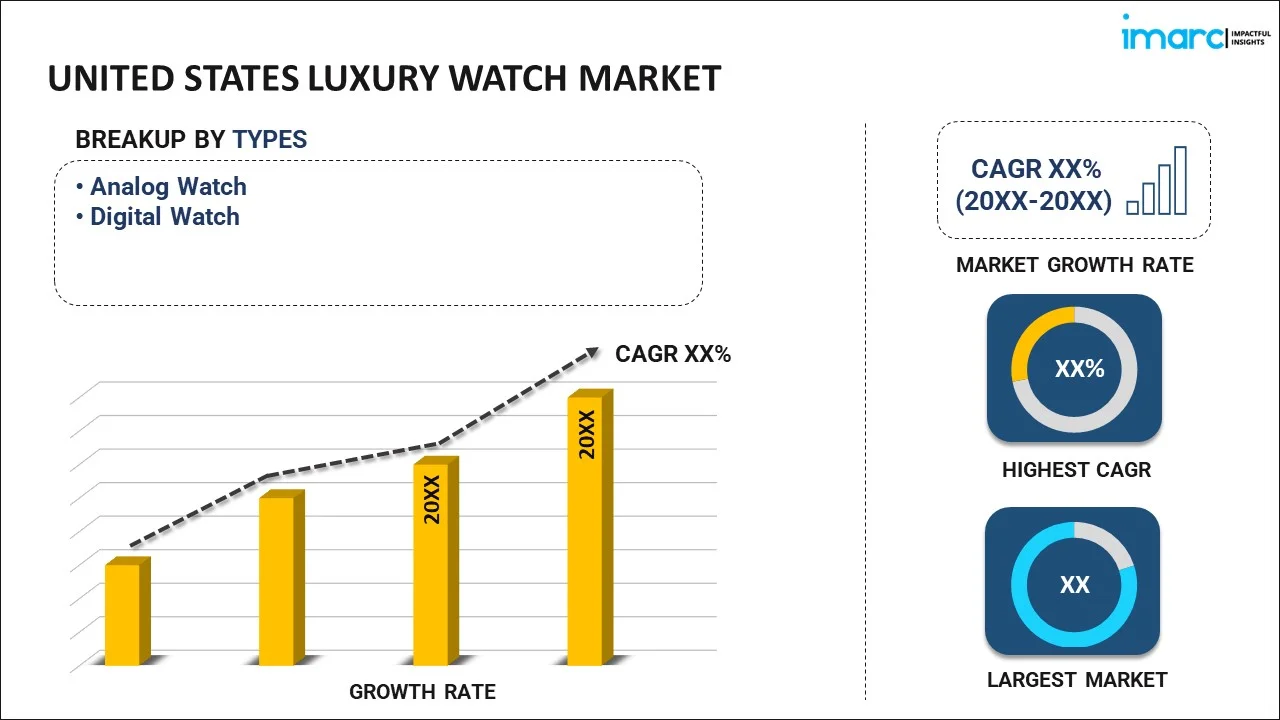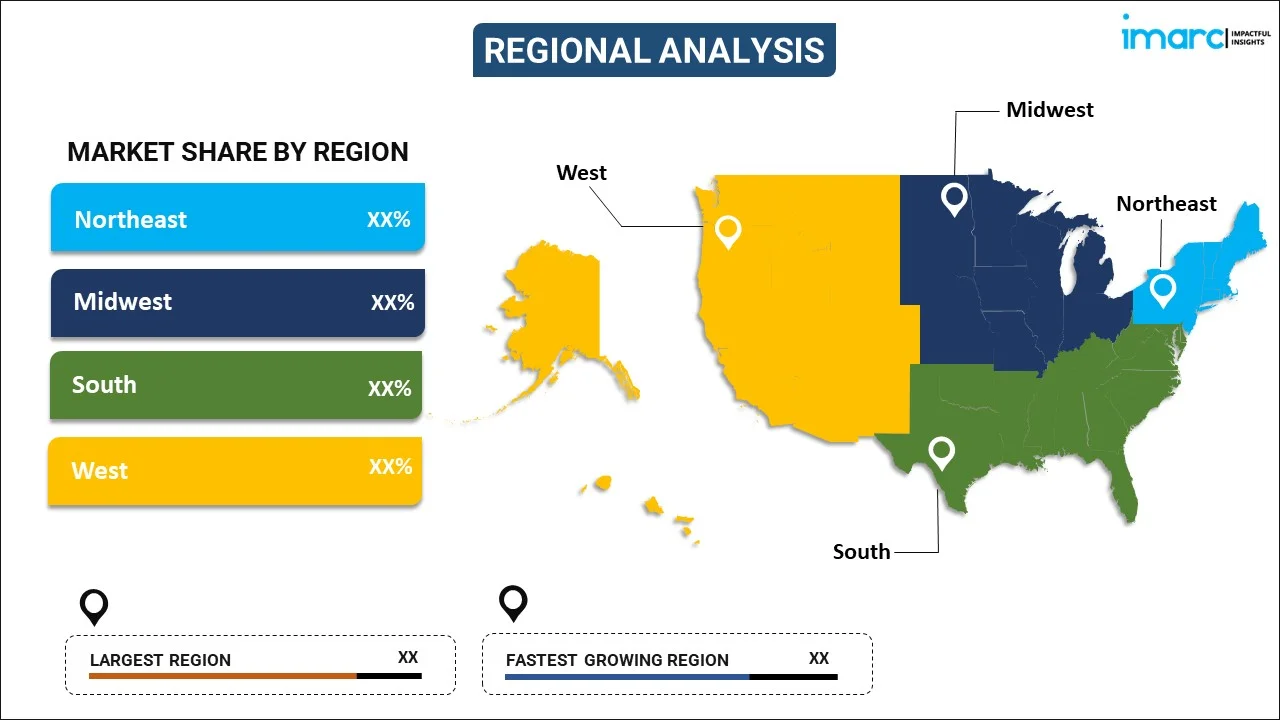
United States Luxury Watch Market Report by Type (Analog Watch, Digital Watch), End User (Women, Men, Unisex), Distribution Channel (Online Stores, Offline Stores), and Region 2025-2033
Market Overview:
The United States luxury watch market size reached USD 7.8 Billion in 2024. Looking forward, IMARC Group expects the market to reach USD 16.2 Billion by 2033, exhibiting a growth rate (CAGR) of 8.4% during 2025-2033. The rising inclination towards high-end timepieces as symbols of status and achievement among the affluent population, an increasing fascination with mechanical and vintage watches, and the introduction of limited-edition releases and unique collaborations represent some of the key factors driving the market.
|
Report Attribute
|
Key Statistics
|
|---|---|
|
Base Year
|
2024 |
|
Forecast Years
|
2025-2033
|
|
Historical Years
|
2019-2024
|
| Market Size in 2024 | USD 7.8 Billion |
| Market Forecast in 2033 | USD 16.2 Billion |
| Market Growth Rate (2025-2033) | 8.4% |
A luxury watch is a premium timepiece often produced by renowned brands, distinguished by superior craftsmanship, high-quality materials, and excellent performance. With a fine balance of technological sophistication and aesthetic appeal, it serves as a symbol of personal style, status, and often a good investment. These watches are typically made from high-quality materials such as gold, platinum, and gemstones, and house intricate, mechanical movements that require exceptional skill and artistry to assemble. Mechanical watches consist of a complex series of tiny components working together, including a mainspring and a series of gears, to track time accurately. Automatic watches are similar but include a rotor that winds the mainspring through the natural motion of the wearer's wrist. Moreover, many variants come with additional functions, including chronographs, moon phase indicators, and calendars. Additionally, they feature sophisticated designs, ranging from classic to contemporary, and bear the signature style of the brand, ensuring instant recognition. These watches exhibit superior resistance to wear and tear, water, and sometimes even magnetic fields and are also expected to perform with high accuracy and minimal deviation over a long period. The intrinsic value of these watches is derived from the components and functions, inherent exclusivity, brand reputation, and the level of detail involved in the manufacturing.
United States Luxury Watch Market Trends:
The market in the United States is primarily driven by the rising inclination towards high-end timepieces as symbols of status and achievement among the growing affluent population. In addition to this, an increasing fascination with mechanical watches, coupled with their investment value, are propelling market growth. Moreover, the augmenting popularity of online retail, with the advantage of global exposure and 24/7 availability, has made luxury watches more accessible, which in turn is creating a positive market outlook. In line with this, creating a sense of urgency and desire among collectors and enthusiasts are also acting as a significant growth inducing factor for the market. The market is further driven by the rising consumer desire for personalization and bespoke watches with a unique, tailored experience. Besides this, the accelerating interest in vintage and pre-owned luxury watches among the masses is resulting in the rapid expansion of a secondary market, which is creating lucrative opportunities in the market. Furthermore, continual technological advancements enabling the integration of smart features within traditional luxury watch designs are impacting the market favorably. Apart from this, innovative marketing campaigns by the major manufacturers, including celebrity endorsements and strategic partnerships with high-profile events to enhance brand appeal are fueling the market. Some of the other factors contributing to the market include the advent of eco-friendly materials and manufacturing processes, considerable growth in watchmaking workshops and increasing brand heritage tours.
United States Luxury Watch Market Segmentation:
IMARC Group provides an analysis of the key trends in each segment of the United States luxury watch market report, along with forecasts at the country level for 2025-2033. Our report has categorized the market based on type, end user, and distribution channel.
Type Insights:

- Analog Watch
- Digital Watch
The report has provided a detailed breakup and analysis of the market based on the type. This includes analog watch and digital watch.
End User Insights:
- Women
- Men
- Unisex
A detailed breakup and analysis of the market based on the end user has also been provided in the report. This includes women, men, and unisex.
Distribution Channel Insights:
- Online Stores
- Offline Stores
A detailed breakup and analysis of the market based on the distribution channel has also been provided in the report. This includes online stores and offline stores.
Regional Insights:

- Northeast
- Midwest
- South
- West
The report has also provided a comprehensive analysis of all the major regional markets, which include Northeast, Midwest, South, and West.
Competitive Landscape:
The report has also provided a comprehensive analysis of the competitive landscape in the market. Competitive analysis such as market structure, key player positioning, top winning strategies, competitive dashboard, and company evaluation quadrant has been covered in the report. Also, detailed profiles of all major companies have been provided.
United States Luxury Watch Market Report Coverage:
| Report Features | Details |
|---|---|
| Base Year of the Analysis | 2024 |
| Historical Period | 2019-2024 |
| Forecast Period | 2025-2033 |
| Units | Billion USD |
| Scope of the Report | Exploration of Historical and Forecast Trends, Industry Catalysts and Challenges, Segment-Wise Historical and Predictive Market Assessment:
|
| Types Covered | Analog Watch, Digital Watch |
| End Users Covered | Women, Men, Unisex |
| Distribution Channels Covered | Online Stores, Offline Stores |
| Regions Covered | Northeast, Midwest, South, West |
| Customization Scope | 10% Free Customization |
| Post-Sale Analyst Support | 10-12 Weeks |
| Delivery Format | PDF and Excel through Email (We can also provide the editable version of the report in PPT/Word format on special request) |
Key Questions Answered in This Report:
- How has the United States luxury watch market performed so far and how will it perform in the coming years?
- What has been the impact of COVID-19 on the United States luxury watch market?
- What is the breakup of the United States luxury watch market on the basis of type?
- What is the breakup of the United States luxury watch market on the basis of end user?
- What is the breakup of the United States luxury watch market on the basis of distribution channel?
- What are the various stages in the value chain of the United States luxury watch market?
- What are the key driving factors and challenges in the United States luxury watch market?
- What is the structure of the United States luxury watch market and who are the key players?
- What is the degree of competition in the United States luxury watch market?
Key Benefits for Stakeholders:
- IMARC’s report offers a comprehensive quantitative analysis of various market segments, historical and current market trends, market forecasts, and dynamics of the United States luxury watch market from 2019-2033.
- The research study provides the latest information on the market drivers, challenges, and opportunities in the United States luxury watch market.
- Porter's five forces analysis assist stakeholders in assessing the impact of new entrants, competitive rivalry, supplier power, buyer power, and the threat of substitution. It helps stakeholders to analyze the level of competition within the United States luxury watch industry and its attractiveness.
- Competitive landscape allows stakeholders to understand their competitive environment and provides an insight into the current positions of key players in the market.
Need more help?
- Speak to our experienced analysts for insights on the current market scenarios.
- Include additional segments and countries to customize the report as per your requirement.
- Gain an unparalleled competitive advantage in your domain by understanding how to utilize the report and positively impacting your operations and revenue.
- For further assistance, please connect with our analysts.
 Request Customization
Request Customization
 Speak to an Analyst
Speak to an Analyst
 Request Brochure
Request Brochure
 Inquire Before Buying
Inquire Before Buying




.webp)




.webp)












